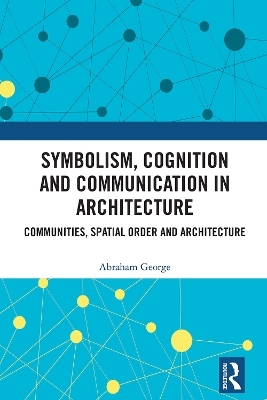
Symbolism, Cognition and Communication in Architecture
Routledge India (Verlag)
978-0-367-53677-0 (ISBN)
This book discusses the role and significance of symbols and symbolism in graphical communication toward the establishment of meaningful architecture. It explores how these are effectively applied in architectural education for the empowerment of learners in various cultures around the world. The volume examines the developments in graphic representations while recognizing the importance of cognition and its perception in spatial terms. In a scenario where architectural education is at crossroads, facing challenges of a global nature, this book highlights the importance of understanding architectural curriculum and design subjects. The author discusses the issues of communicating the knowledge of architecture to heterogeneous groups of students and explains how design fields and learning in architecture can be modified through cognitive instructional methods. The book outlines the methodology to develop symbols and symbolic pedagogical tools for effective communication in architecture. The book will appeal to students, researchers, teachers and scholars of architecture, design, planning and visual communication. It will also be of interest to architects, artists, spatial designers, town planners, urban planners and professionals.
Abraham George was born on 7 December 1963. He graduated with First Rank in B. Arch from the University of Kerala in December 1986, secured an M. Arch with Excellent Grade from the Indian Institute of Technology Kharagpur in 1991 and earned a Ph.D. in development of symbolic tools for communication in architecture from Calicut University in 2005 with Fulbright Fellowship granted for the research. He is currently a professor and former head of the Department of Architecture and Regional Planning, Indian Institute of Technology Kharagpur. He worked as an active faculty member of the Department of Architecture, later the head of the Department of Architecture, National Institute of Technology Calicut, till January 2009, and has contributed to the cause of architecture through institution development and numerous building and interior projects, including the prestigious administrative complex of NITC, research projects, numerous published papers, teaching and invited lectures. He was awarded the John Crawford Scholarship by the Government of Australia, 1992, and the Fulbright Research Fellowship 2003–04 with center of research at the Department of Architecture, Cornell University, New York. The Nehru Trust for Cambridge Collections, Victoria Albert Museum, UK, awarded him a research grant for 2005–06. His paper ‘Gazing into the Future of Architecture: An Evolving Profession’ was awarded the Best Faculty Paper Award in the Golden Jubilee Conference of School of Architecture and Planning Chennai, February 2008. Two other Best Paper awards were conferred by IIT Roorkee and VIT Vellore. He is currently a member of the Board of Studies of the School of Architecture and Planning, National Institute of Technology Patna, Anna University and University of Calicut; a member of the Editorial Board of (i) Education and Practice published by IISTE US, (ii) ICFAI Journal of Architecture, Journal of Emerging Trends in Educational Research and Policy Studies (JETERAPS), reviewer, (iii) Journal of Architectural Engineering, American Society of Civil Engineers, (iv) Journal of Design Studies, published by IISTE US; and a member of the review panel of International Congress, Petronas University, Kuala Lumpur. He worked as the chairman, Academic Board, IIA Kerala Chapter, and the vice-chairman, Indian Institute of Architects, Calicut Center, till February 2009. Formerly, he contributed as the head of the Department of Architecture and gladly built up the Department of Architecture, NIT Calicut to the national level accredited by the Council of Architecture in the year 2009. He worked as Associate Professor from January 29, 2009, at the Department of Architecture and Regional Planning, Indian Institute of Technology Kharagpur, till August 08, 2020. During his tenure he guided eleven PhD candidates; four are awarded, one is submitted and six are ongoing. He has completed a mega-project on Age-Friendly Built Forms and Infrastructure Design, sponsored by MHRD, Government of India, and two other projects on Youth Empowerment through Mud Block Making and the Influence of Print Journalism on Architectural Design, both sponsored by SRIC, IIT Kharagpur. International exposure and collaborative research work are essential for students to gain confidence, self-worth and the capability to compete internationally. He has initiated international student exchanges at the department with two M. Arch students from Leibnitz University, Hannover. He is entrusted with the responsibility of forging the relationship with Leibnitz University, Hannover and formed an MoU with the university. Further, he has put in efforts and formed another MoU with the Auro Society, Pondicherry, an organization of repute with IIT Kharagpur. As the MoU officer, he facilitates mutual collaborations and research work. Architectural research, education leading to student empowerment and architectural practice are his lifetime goals. He has more than seventy scientific papers and has served on the Panel of Experts in the All India Council for Technical Education, in facultyrecruitment for National Institutes of Technologies and in many Ph.D. examinations by various universities in India.
Introduction 1. Symbols, Symbolism and Cognition in communication 2. Architectural Symbolism and its Manifestations 3. Cognition, Signs and Symbolism in Architecture 4. Architecture as a Signifying Communication System 5. Development of Graphic Communication 6. Communication Through Symbols in Architecture 7. Graphic Equivalents and Cognitive Tools
| Erscheinungsdatum | 10.07.2024 |
|---|---|
| Zusatzinfo | 28 Tables, black and white; 17 Line drawings, black and white; 27 Halftones, black and white; 44 Illustrations, black and white |
| Verlagsort | London |
| Sprache | englisch |
| Maße | 156 x 234 mm |
| Gewicht | 453 g |
| Themenwelt | Naturwissenschaften ► Biologie ► Ökologie / Naturschutz |
| Sozialwissenschaften ► Kommunikation / Medien ► Kommunikationswissenschaft | |
| Sozialwissenschaften ► Soziologie ► Spezielle Soziologien | |
| Technik ► Architektur | |
| ISBN-10 | 0-367-53677-3 / 0367536773 |
| ISBN-13 | 978-0-367-53677-0 / 9780367536770 |
| Zustand | Neuware |
| Informationen gemäß Produktsicherheitsverordnung (GPSR) | |
| Haben Sie eine Frage zum Produkt? |
aus dem Bereich


